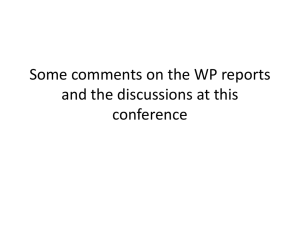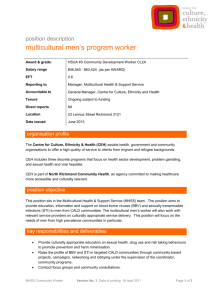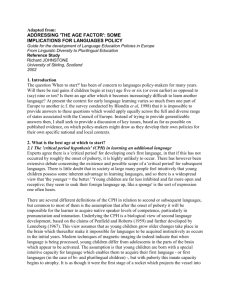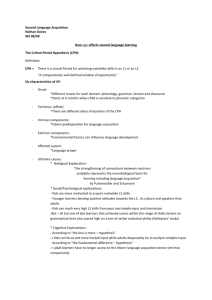Review of the Role of Mental Health Cultural Portfolio Holders and
advertisement
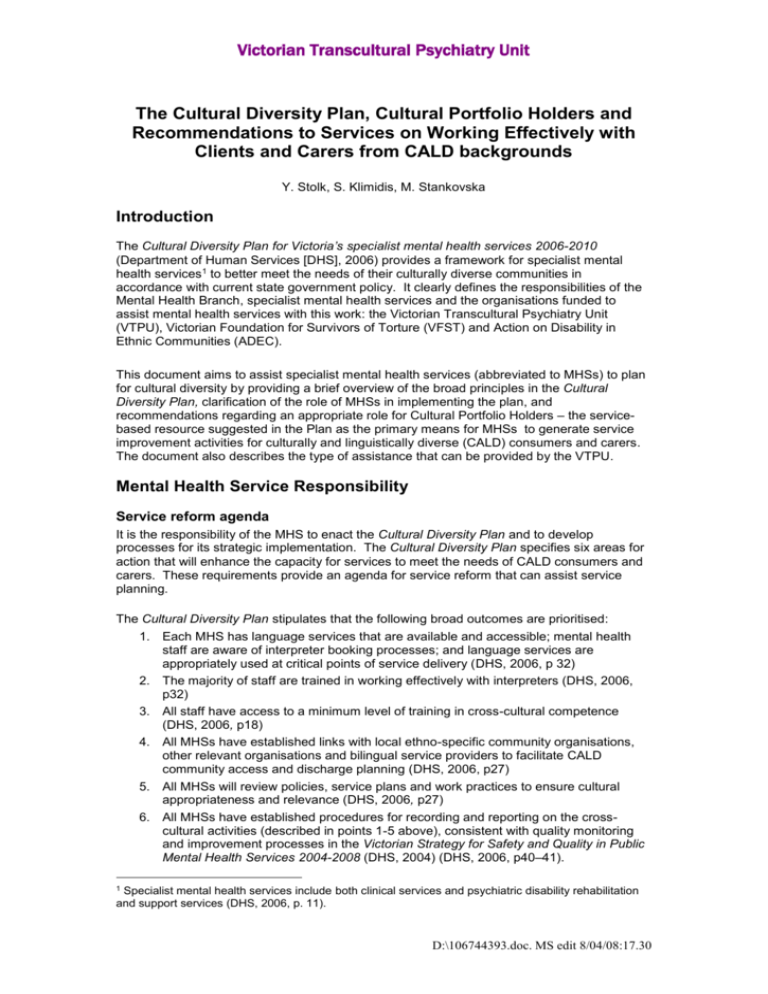
Victorian Transcultural Psychiatry Unit The Cultural Diversity Plan, Cultural Portfolio Holders and Recommendations to Services on Working Effectively with Clients and Carers from CALD backgrounds Y. Stolk, S. Klimidis, M. Stankovska Introduction The Cultural Diversity Plan for Victoria’s specialist mental health services 2006-2010 (Department of Human Services [DHS], 2006) provides a framework for specialist mental health services1 to better meet the needs of their culturally diverse communities in accordance with current state government policy. It clearly defines the responsibilities of the Mental Health Branch, specialist mental health services and the organisations funded to assist mental health services with this work: the Victorian Transcultural Psychiatry Unit (VTPU), Victorian Foundation for Survivors of Torture (VFST) and Action on Disability in Ethnic Communities (ADEC). This document aims to assist specialist mental health services (abbreviated to MHSs) to plan for cultural diversity by providing a brief overview of the broad principles in the Cultural Diversity Plan, clarification of the role of MHSs in implementing the plan, and recommendations regarding an appropriate role for Cultural Portfolio Holders – the servicebased resource suggested in the Plan as the primary means for MHSs to generate service improvement activities for culturally and linguistically diverse (CALD) consumers and carers. The document also describes the type of assistance that can be provided by the VTPU. Mental Health Service Responsibility Service reform agenda It is the responsibility of the MHS to enact the Cultural Diversity Plan and to develop processes for its strategic implementation. The Cultural Diversity Plan specifies six areas for action that will enhance the capacity for services to meet the needs of CALD consumers and carers. These requirements provide an agenda for service reform that can assist service planning. The Cultural Diversity Plan stipulates that the following broad outcomes are prioritised: 1. Each MHS has language services that are available and accessible; mental health staff are aware of interpreter booking processes; and language services are appropriately used at critical points of service delivery (DHS, 2006, p 32) 2. The majority of staff are trained in working effectively with interpreters (DHS, 2006, p32) 3. All staff have access to a minimum level of training in cross-cultural competence (DHS, 2006, p18) 4. All MHSs have established links with local ethno-specific community organisations, other relevant organisations and bilingual service providers to facilitate CALD community access and discharge planning (DHS, 2006, p27) 5. All MHSs will review policies, service plans and work practices to ensure cultural appropriateness and relevance (DHS, 2006, p27) 6. All MHSs have established procedures for recording and reporting on the crosscultural activities (described in points 1-5 above), consistent with quality monitoring and improvement processes in the Victorian Strategy for Safety and Quality in Public Mental Health Services 2004-2008 (DHS, 2004) (DHS, 2006, p40–41). 1 Specialist mental health services include both clinical services and psychiatric disability rehabilitation and support services (DHS, 2006, p. 11). D:\106744393.doc. MS edit 8/04/08:17.30 2 Cultural Portfolio Holders The Cultural Diversity Plan also stipulates that every MHS should appoint a Cultural Portfolio Holder (CPH) to support implementation of the Cultural Diversity Plan (DHS, 2006, p. 25). Appointment of a CPH by each MHS will facilitate implementation of the goals of the Service Reform Agenda mentioned above. The appointment of CPHs by services also provides a means of connecting with the VTPU for assistance and support. The VTPU investigated issues in implementing and maintaining the Cultural Portfolio holder role in MHSs by interviewing existing Cultural Portfolio holders (see Appendix 1). The findings from this investigation informed development of the following recommendations regarding the appointment, implementation, ongoing support, and effective use of the role of Cultural Portfolio Holder. Organisational location of Cultural Portfolio Holders in MHS The broad responsibility of the CPH is to support the MHS as it enacts the Cultural Diversity Plan and develops processes for its strategic implementation. To enable the CPH to function effectively it is recommended that the CPH role: 1. Be undertaken by someone with leadership qualities and at a level of appointment with access to managerial decision-making 2. Has sufficient authority to develop and implement policy, including the development of service structures and processes, projects and collaborations 3. Aims to integrate CALD service improvement planning with overall service quality improvement planning 4. Be recognised by the service with an allocation of EFT dedicated to the portfolio, depending on the CALD population density of the catchment area 5. Has responsibility for no more than one mental health service (as designated by the DHS2). If there is responsibility for more than one service, this should be recognised through a pro-rata increase of EFT 6. Has a working space/office where pressures to respond to clinical issues can be avoided 7. Addresses CALD issues across all teams and pathways of care. Broad proposed areas of responsibility of Cultural Portfolio Holders The responsibility of the CPH is to assist the MHS to promote culturally sensitive service provision in the MHS and to facilitate service access by members of ethnic communities. To achieve these objectives the following activities (which are neither prescriptive nor exhaustive) may be undertaken, in consultation with MHS management and consistent with the MHS Quality Improvement Plan: 1. Establish support structures (e.g., Cultural Working Group) to promote the implementation of the Cultural Diversity Plan for Victoria’s Specialist Mental Health Services 2006-2010 (DHS, 2006) 2. Act as a contact point for communication within the MHS as well as between the MHS and VTPU 3. In collaboration with appropriate support structures (see point 1) identify and respond to service priorities consistent with the Service Reform Agenda and overall service planning 4. Disseminate resources, foster cross-cultural education and community liaison 5. Disseminate relevant information and/or statistical data in order to support the development of strategies and procedures for service improvements 2 See DHS website for delineation of mental health services http://www.health.vic.gov.au/mentalhealth/services/index.htm 3 6. Liaises regularly with other CPHs and VTPU for mutual learning, information sharing, and planning of cross-catchment collaborative projects 7. Obtains support from the VTPU by participating in regular VTPU CPH support meetings. Support for mental health services by the VTPU The VTPU is available to support and assist MHSs to meet the requirement of the Cultural Diversity Plan in providing high quality mental health services to clients and carers from immigrant backgrounds. As such, the provision of support and assistance to Cultural Portfolio Holders is a priority. A range of services are offered, including consultancy in service planning and development, education and professional development, and the provision of direct information and advice. The consultancy support in service planning and development comprises activities that aim to assist services to improve the design and delivery of services to people from CALD backgrounds. This includes assistance with: Policy development Needs identification and prioritisation Integrating CALD responsiveness into existing service protocols and structures Assisting CPHs to build capacity within the service Developing resources to support staff Linkage with ethnic communities, and Information on evidence-based service provision models, cross-cultural research or resources that may be useful. The VTPU Education and Professional Development program includes: Discrete in-service sessions across a wide range of themes designed to enhance the knowledge and skills of mental health staff in assessing and managing the mental health and well-being of people from CALD backgrounds. Sessions have a duration ranging from two hours to a full day and are held on-site at mental health services Monthly seminars in the field of transcultural mental health practice held at the VTPU Monthly clinical case discussions held at the VTPU, and Interactive workshops designed to explore important aspects of culture, communication and difference in transcultural mental health, also held at the VTPU or in rural or service locations by arrangement. Further, the VTPU provides a telephone and email information and advice support service to assist clinicians and other mental health services staff in their work with clients and carers from immigrant backgrounds. Detailed information about VTPU programs and resources may be found at: http://www.vtpu.org.au References Department of Human Services (2004). Victorian Strategy for Safety and Quality in Public Mental Health Services 2004-2008. Melbourne: DHS. Department of Human Services (2006). Cultural Diversity Plan for Victoria’s Specialist Mental Health Services 2006-2010. www.health.vic.gov.au/mentalhealth/publications/caldstrategy.pdf 4 Appendix 1 Roles of Current Portfolio Holders Interviews were held with four existing CPHs in June, 2007 to clarify the development of the role, position description, nature of activities engaged in, and factors that limited or enhanced performance of the role. CPHs ranged in experience from one having recently been appointed, to three having a substantial working history in the CPH role. Conclusions reached from the investigation were as follows: 1. CPHs ability to enact reform and relevant quality improvements appeared to be related to their level of appointment. While personal interest in the role was beneficial in a favourable service environment, reliance on personal commitment makes the role fragile as departure of the individual is likely to lead to discontinuation of relevant activities. Thus a sustainable solution needs to be considered. 2. CPHs lacking access to the service’s executive experienced a sense of isolation, uncertainty and a lack of guidance in developing and implementing projects relevant to improving access and equity for CALD communities. 3. Models of the CPH role varied according to whether the CPH worked alone, the level of access to executive/management committees within the service, availability of a cultural working group, support from the VTPU, level of collaboration with the VTPU, level of integration of the CPH role in their usual role in the service and, where access to executive decision processes was low, access to local management to support the CPH role. 4. CPHs with responsibility for services with multiple sites and programs experienced problems of geographical and functional inaccessibility, that is, limited reach of activities inside the various components of the service to implement quality improvements. 5. It was felt that it would be beneficial if the CPH role was functionally tied with quality improvement processes in collaboration with the quality manager. 6. It was not clear whether current CPH activities were as yet guided by the Victorian Cultural Diversity Plan, though they were consistent with its general direction. Local assessments of issues of priority were an important driver of activity.

